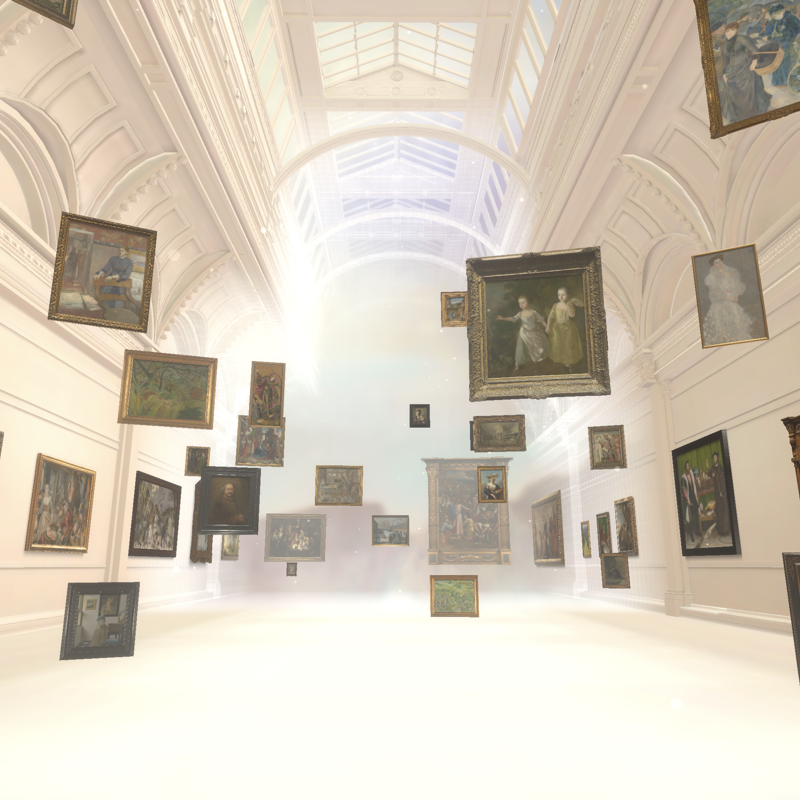Pieter de Hooch, 'The Courtyard of a House in Delft', 1658
About the work
Overview
In the sunlight of a quiet afternoon this courtyard seems to radiate tranquillity. Everything is still, including the figures: a young maid, clean and calm, who holds the hand of a little girl, and the shadowy figure of a woman in the passageway to the left, presumably the child’s mother, who turns towards the houses opposite her own. De Hooch placed the mother in the formal part of the house, painted in architectural detail, while the maid and the child stand in an area closer to nature.
The picture shows de Hooch’s skill in depicting architecture, but it’s also a vision of women’s role in the stability of the home. At the time this was painted, treatises were being written on household and family management; Jacob Cats’s Houwelyck was addressed directly to women, its chapters divided into Maiden, Sweetheart, Bride, Housewife, Mother and Widow. Some artists, including de Hooch, presented pictures that were a confirmation and encouragement of the ideals put forward in such books.
Key facts
Details
- Full title
- The Courtyard of a House in Delft
- Artist
- Pieter de Hooch
- Artist dates
- 1629 - after 1684
- Date made
- 1658
- Medium and support
- oil on canvas
- Dimensions
- 73.5 × 60 cm
- Inscription summary
- Signed; Dated and inscribed
- Acquisition credit
- Bought, 1871
- Inventory number
- NG835
- Location
- Room 16
- Collection
- Main Collection
- Previous owners
- Frame
- 17th-century Dutch Frame
Provenance
Additional information
Text extracted from the ‘Provenance’ section of the catalogue entry in Neil MacLaren, revised and expanded by Christopher Brown, ‘National Gallery Catalogues: The Dutch School: 1600–1900’, London 1991; for further information, see the full catalogue entry.
Exhibition history
-
2009Vermeer, Fabritius and De Hooch: Three Masterpieces from DelftNational Gallery of Ireland14 February 2009 - 24 May 2009
-
2011Vermeer's Women: Secrets and SilenceThe Fitzwilliam Museum5 October 2011 - 15 January 2012
-
2015Class Distinctions: Dutch Painting in the Age of Rembrandt and VermeerMuseum of Fine Arts, Boston11 October 2015 - 18 January 2016The Nelson-Atkins Museum of Art20 February 2016 - 29 May 2016
-
2019Pieter de Hooch: From the Shadow of VermeerMuseum Prisenhof Delft11 October 2019 - 16 February 2020
Bibliography
-
1829
J. Smith, A Catalogue Raisonné of the Works of the Most Eminent Dutch, Flemish, and French Painters: In Which is Included a Short Biographical Notice of the Artists, with a Copious Description of Their Principal Pictures […], 9 vols, London 1829-1842
-
1834C.-J. Nieuwenhuys, A Review of the Lives and Works of Some of the Most Eminent Painters, London 1834
-
1844A.M. Jameson, Companion to the Most Celebrated Private Galleries of Art in London: Containing Accurate Catalogues, Arranged Alphabetically, for Immediate Reference, Each Preceded by an Historical & Critical Introduction […], London 1844
-
1854G.F. Waagen, Treasures of Art in Great Britain: Being and Account of the Chief Collections of Paintings, Drawings, Sculptures, Illuminated Mss. […], vol. 2, trans. E. Eastlake, London 1854
-
1907C. Hofstede de Groot, Catalogue Raisonné of the Works of the Most Eminent Dutch Painters of the Seventeenth Century, 10 vols, London 1907
-
1907C. Hofstede de Groot, Catalogue Raisonné of the Works of the Most Eminent Dutch Painters of the Seventeenth Century, 10 vols, London 1907
-
1930W.R. Valentiner, Das unbekannte Meisterwerk in Öffentlichen und privaten Sammlungen, New York 1930
-
1960Maclaren, Neil, National Gallery Catalogues: The Dutch School, 2 vols, London 1960
-
1983C. Brown, 'Rubens' Watering Place: An Examination of His Landscape Technique', Ringling Museum of Art Journal, 1983, pp. 130-49
-
1991Maclaren, Neil, revised by Christopher Brown, National Gallery Catalogues: The Dutch School, 1600-1900, 2nd edn (revised and expanded), 2 vols, London 1991
-
1992B.L. Brown et al., Jacopo Bassano, c. 1570-1592 (exh. cat. Museo Civico, 5 September - 6 December 1992; Kimbell Art Museum, 23 January - 25 April 1993), Bassano del Grappa 1992
-
1997National Gallery, 'Pictures Cleaned and Restored in the Conservation Department of the National Gallery, October 1997 - January 2000', National Gallery Technical Bulletin, XXI, 2000
-
1998P. Sutton, Pieter de Hooch (exh. cat. Dulwich Picture Gallery, 3 September - 15 November 1998; Wadsworth Athenaeum, 17 December 1998 - 27 February 1999), London 1998
-
2001
C. Baker and T. Henry, The National Gallery: Complete Illustrated Catalogue, London 2001
-
2001R. Baarsen et al., Vermeer and the Delft School, New Haven 2001
-
2004J. Giltaij, Senses and Sins: Dutch Painters of Daily Life in the Seventeenth Century (exh. cat. Museum Boijmans Van Beuningen, 23 October 2004 - 9 January 2005; Städtische Galerie im Städelschen Kunstinstitut, 10 February - 1 May 2005), Ostfildern-Ruit 2004
Frame
This Dutch ripple frame dates to the seventeenth century. An ebonised pearwood frame, it has three different types of ripple moulding. The widest ripple is found at the top profile, leading to an ogee section and a two-line ripple above the frieze. The raised sight edge features the last of the three ripple mouldings, showcasing the most popular type of ripple design.
The ripple effect would have been produced using a machine that moved up and down the frame to create the pattern. Despite the discovery in Germany of the oldest-known ripple-moulding machine, frames with these ripples – commonly made in Europe during this period – are referred to as Dutch ripple frames.
This frame was fitted to de Hooch’s The Courtyard of a House in Delft in 2021.
About this record
If you know more about this work or have spotted an error, please contact us. Please note that exhibition histories are listed from 2009 onwards. Bibliographies may not be complete; more comprehensive information is available in the National Gallery Library.






